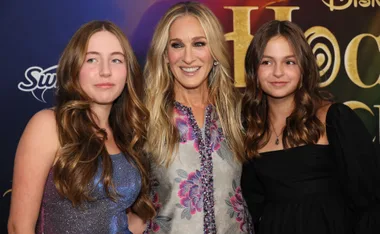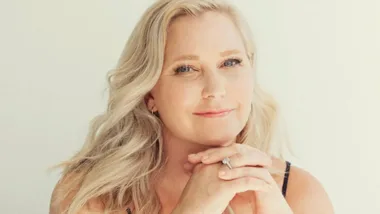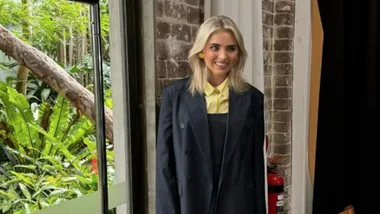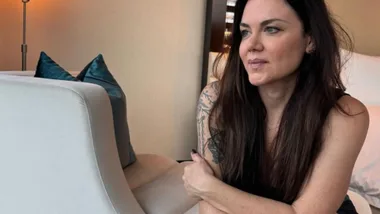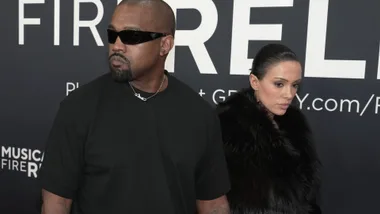By day, they’re students, mums and businesswomen, but they moonlight as environmental activists, staging dramatic protests, taking on the police and even quitting their jobs to fight for our planet. Alley Pascoe meets the new revolutionaries
A war cry is echoing through the streets of Sydney. It bounces off the sandstone city buildings and surges to a roaring crescendo in Hyde Park. It’s as much a desperate plea as it is an urgent demand. “What do we want? Climate action. When do we want it? Now!” chants the crowd of about 80,000 Australians, united in their fury.
Erin Remblance is one of them. She’s left her young kids at home so she can march – and shout – through the CBD streets at the School Strike 4 Climate rally, holding a sign that reads, ‘We’ve reached our tipping point, don’t let the climate do the same.’
A 38-year-old mum-of-three, wearing a buttoned-up Ginger & Smart shirt dress with her blonde hair cropped in a neat bob, Remblance is not your average striker – in fact, until that warm spring day in September 2019, she’d never attended a protest. But in October 2018, she was propelled into action after reading the 2018 UN Intergovernmental Panel on Climate Change (IPCC) report, in which the world’s leading climate scientists drew a line in the sand. They warned: if we don’t make dramatic changes and reduce greenhouse gas emissions by 2030, we will face extreme heat, catastrophic droughts and floods, and unprecedented natural disasters including bushfires and cyclones. Remblance recalls the panic that washed over her and the adrenaline running through her body as she processed each chilling fact. And she realised if the Australian Government wasn’t going to take action to save the planet, she personally would.

Since then, Remblance has gone vegan, reduced her family’s carbon emissions and joined the Australian Parents for Climate Action group. She regularly writes to members of parliament and posts harsh truths on social media, including this quote from human rights activist Ginetta Sagan: “Silence in the face of injustice is complicity with the oppressor.” And of course, she takes to the streets and protests. “It was reassuring to see so many people turn up and have their presence felt,” she says of last year’s School Strike 4 Climate rally, inspired by activist Greta Thunberg and attended by more than 300,000 people in Australia and millions worldwide.
Remblance is part of a growing group of everyday Australians feeling increasingly anxious about the climate crisis. A recent survey by research group Ipsos revealed that from May 2019 to January 2020, the proportion of Australians citing climate change as their key concern increased from 24 per cent to 41 per cent, coming ahead of issues such as healthcare and the cost of living. At last year’s federal election the climate crisis was the fourth most important issue facing the nation; now it’s number one. This comes after the nation’s horrific black summer, which saw bushfires ravage 18.6 million hectares of land, destroy 5900 buildings and homes, and kill 34 people and one billion animals.
Yet despite warnings from scientists dating back 30 years, the Australian Government continues to downplay climate change. Over summer, Prime Minister Scott Morrison routinely refused to acknowledge the link between the bushfires and global warming, and insisted his government’s climate change policies were adequate – ignoring the fact that the 2020 Climate Change Performance Index ranked Australia last out of 57 countries on its climate change policy.
As Australians fume at political inaction, many are taking matters into their own hands – and they’re not the far-left greenies or long-term environmentalists you might expect. A new face of activism is emerging, and it looks like your Liberal-voting North Shore neighbour, your kid’s science teacher and your highly educated local doctor. And they’re women…
Women such as Margot Cunich, a GP of 40 years who’s based in Sydney’s Bondi Junction and is leading the “Quiet Australians” revolution.

Choking on smoke-thick air during her summer holiday on the fire-ravaged New South Wales South Coast late last year, Cunich decided she needed to take action. “When we saw the ferocity and the extent of the bushfires and the devastation to people, animals and the bush, it was a wake-up call. We cannot ignore the climate crisis anymore. Until now, I think people have been a bit complacent, assuming the government will save us, but they haven’t done anything,” says Cunich, 65, whose anger at the government has compelled her to protest for the first time in her life. Alongside her husband Rod, a semi-retired lawyer, she took to the streets and held a silent vigil for climate action outside the office of their federal MP, Liberal politician Dave Sharma, in the eastern suburbs. More than 250 fellow “Quiet Australians” attended the protest (the title played on Morrison’s election jargon praising the silent majority – ironically, referring to those who don’t campaign in the streets or go to protests). “We wanted to show parliamentarians that there are plenty of people who care about the environment, even if they’re not making a lot of noise,” explains Cunich, who is campaigning for evidence-based climate policy.
She may not look like the ‘typical’ megaphone-wielding activist, but Cunich is a force to be reckoned with. “At a recent vigil, a man drove past and yelled out the window, ‘Get a job’,” she reveals. “I was standing next to the CEO of a major company, the head of a public hospital and the owner of a legal firm. These people do have jobs.”
The new rebels taking up arms on the climate crisis frontline do indeed have jobs, and they’re willing to leave them for the cause. At the start of this year, Emily Townsend spectacularly quit her commercial finance job at News Corp over their coverage of the climate crisis. In a company-wide email addressed to executive chairman Michael Miller, Townsend wrote, “I find it unconscionable to continue working for this company, knowing I am contributing to the spread of climate change denial and lies. The reporting I have witnessed … is not only irresponsible but dangerous and damaging to our communities and beautiful planet that needs us more than ever to acknowledge the destruction we have caused and start doing something about it.”
Townsend, 36, who left News Corp to launch an e-commerce hub called WorkIt Spaces that emphasises sustainable practices, explains, “Reading [their] ongoing climate denial every day made me feel incredibly anxious and upset. I knew I couldn’t continue working for an organisation that was contributing to the destruction of our planet. I felt like if I didn’t stand up for the truth and take the action that I took, I would regret it for the rest of my life.”
Townsend isn’t the only person boycotting climate-change deniers. Larissa Payne, the founder of environmental movement Extinction Rebellion Bondi Beach, was part of a protest of hundreds outside News Corp’s Australian headquarters in Sydney’s Surry Hills in February. “We don’t have time for petitions or to wait for the next election cycle, we must act now to stop the climate crisis worsening. Research shows nonviolent direct action enacts lasting peaceful change,” says Payne, 42, a former history teacher who is now a full-time organiser for Extinction Rebellion Sydney, which has about 50,000 Instagram followers.

Protesting next to Payne outside the News Corp offices was Izzy Raj-Seppings. The 13-year-old student made headlines last year when she stared down a police officer who was threatening to arrest her at a protest outside Kirribilli House, where activists were calling for Morrison to return from his holiday in Hawaii to face the bushfire crisis. After dragging her dad along and taking a one-hour bus trip on the hottest day of summer to the protest, Raj-Seppings felt unsettled by the squad of riot police moving through the crowd. In a video that’s now been viewed more than 3.3 million times, a police officer towers over Raj-Seppings, who is in tears, and tells her she’s going to be arrested if she doesn’t comply with a move-on request. As she walks away, she holds her sign high above her head, declaring ‘Look at what you’ve left us. Watch us fight it. Watch us win.’ The crowd cheers.
“I definitely would have been willing to get arrested at the protest. But I had a dentist appointment afterwards, so when we were escorted away, we had to rush to make it,” admits Raj-Seppings, who last year was a normal schoolgirl from Sydney’s Northern Beaches with aspirations of being an actor. Now, the redbandana-wearing teenager has become the face of the climate crisis rebellion in Australia. She’s since been to dozens of protests and is dedicating “almost all” her spare time to activism. “I hope one day I won’t need to take to the streets and protest climate change. As my sign said, I am certain we can win this fight,” says Raj-Seppings, who now dreams of being a politician.
So what exactly are the new revolutionaries fighting for? The common consensus is we need to keep global warming below two degrees or the impact on our planet could be catastrophic. To do this, Australia must take action to drastically reduce its carbon emissions. Remblance cites the IPCC report stating that to reach the target of zero emissions by 2050, we must achieve a 45 per cent decrease on our 2010 emissions by 2030, and reduce emissions by 7.6 per cent each year, every year, for this decade. We’ve not yet achieved that for a single year, let alone 10 years in a row.
If you want a shining example of people doing extraordinary things in the name of the climate emergency, look to Extinction Rebellion. The movement was founded in the UK in 2018 by a small group of British academics with three simple demands for the government: to tell the truth and declare a climate emergency; to halt biodiversity loss and reduce emissions to net-zero by 2025; and to be led by the decisions of a Citizens’ Assembly on climate and ecological justice.
They’ve since become infamous for their extreme protests around the world, where they “use non-violent civil disobedience to disrupt governments, companies and business as usual (because ‘business as usual’ is causing total planetary breakdown and triggering mass murder)”.
In Zurich, Rebels coloured the local river bright green and activists floated down it pretending to be dead in a “die-in”. In London, Rebels led a funeral procession down Oxford Street carrying skeletons and skulls to express their grief and rage over the climate crisis. In Melbourne, Rebels glued themselves to the Kings Bridge and chained themselves together across Collins Street causing “traffic chaos”. In Sydney, Payne heads up the Bondi arm of the movement, and says she would be willing to go to jail for the cause. Extinction Rebellion’s climate targets are more ambitious than most – they say we need to reach net-zero emissions by 2025 or the human race faces extinction – hence the extreme lengths they’re willing to go to.
Of course the movement is not without its critics. As well as being condemned for making people late to work, the rebellion has faced backlash for being too white, too middle class and too elitist. “Extinction Rebellion overwhelmingly reflects the concerns, priorities, and ideas of middle-class white people in rich countries. By doing so, it ends up silencing the stories of our communities, who for hundreds of years have been resisting the root causes of climate change,” wrote activists Tatiana Garavito and Nathan Thanki in their Vice piece: ‘Stop Asking People of Color to Get Arrested to Protest Climate Change’. Payne accepts the judgement.
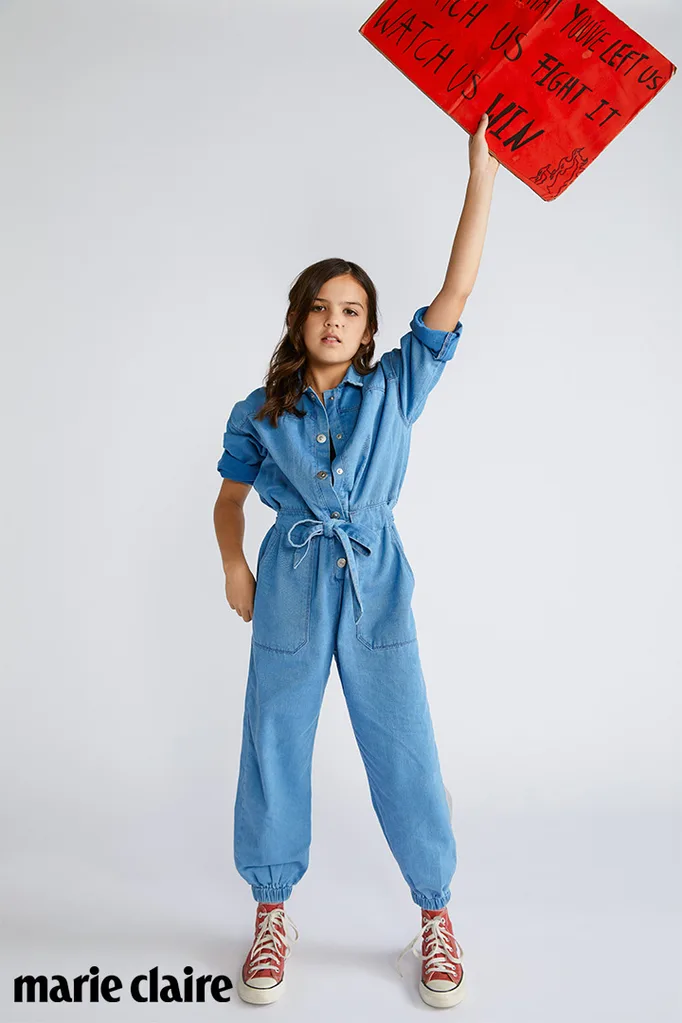
“The white, middle class criticism is, in many ways, fair. We sprouted out of Sydney’s CBD so while it hasn’t been intentional, that does limit accessibility for workers, families and communities who live further from the city. But as the rebellion grows, so too does the diversity of the Rebels. To beat the crisis we need everyone. We have an ethical responsibility to use privilege to fight injustice,” she says, adding that decolonisation is the first step in the rebellion. “First Nations people have been resisting this system, in this place, for over two centuries. They know this land and this resistance best. It is their knowledge, expertise and guidance we respect, not that of the government.”
For Payne, one of the most powerful protests she’s been to was a healing vigil led by Indigenous elders Uncle Greg and Aunty Jacinda, grieving the loss of country and wildlife in the recent bushfire crisis. “We sat together in a traditional smoke healing ceremony and listened to the elders’ message of unity. It was the most spiritually inspiring and hopeful moment I’ve had since joining Extinction Rebellion,” reflects Payne. It is this memory of unity that keeps her motivated when the climate crisis weighs heavily on her shoulders and feels impossible to shake off. Plus this quote from environmental activist Joanna Macy: “If the world is to be healed through human efforts, I am convinced it will be by ordinary people, people whose love for this life is even greater than their fear.”
Holding her now 18-month-old daughter Amélie, Remblance says her greatest hope for her kids’ future is for them to live the lives we’ve been privileged enough to live: breathing fresh air, seeing koalas in the wild, diving at the Great Barrier Reef and not experiencing the terror of fires, floods and frightening weather extremes. She’s already made another sign for her next protest. It reads: ‘Protect the planet’. It’s a simple request and one that hundreds of thousands of Australians are chanting.
Listen up, Scott Morrison: the ordinary rebels are coming for you.
This article originally appeared in the May issue of marie claire: on sale now.


